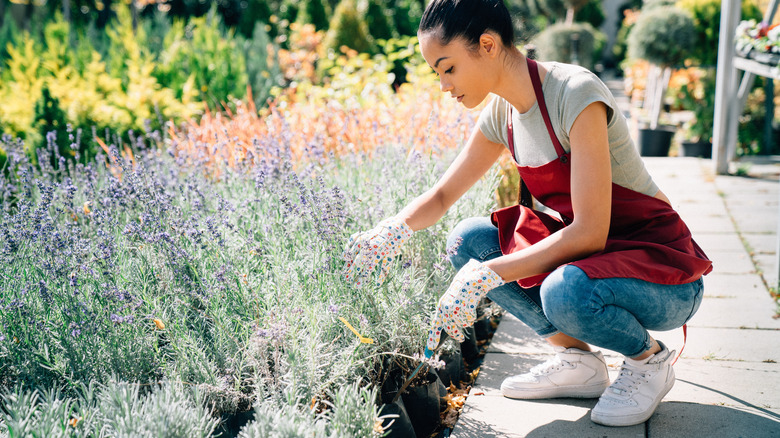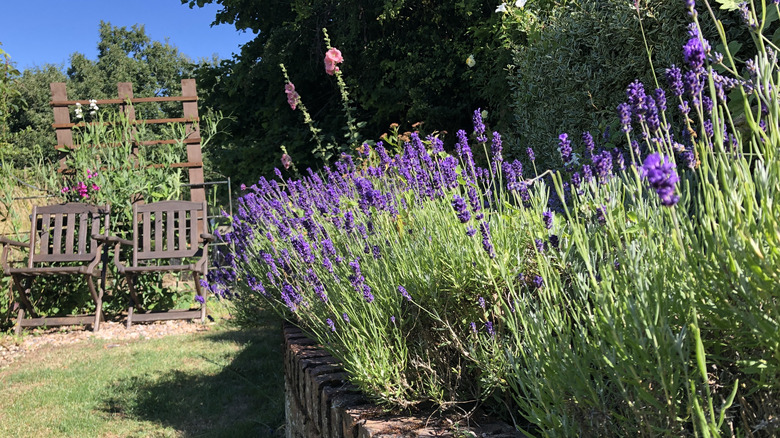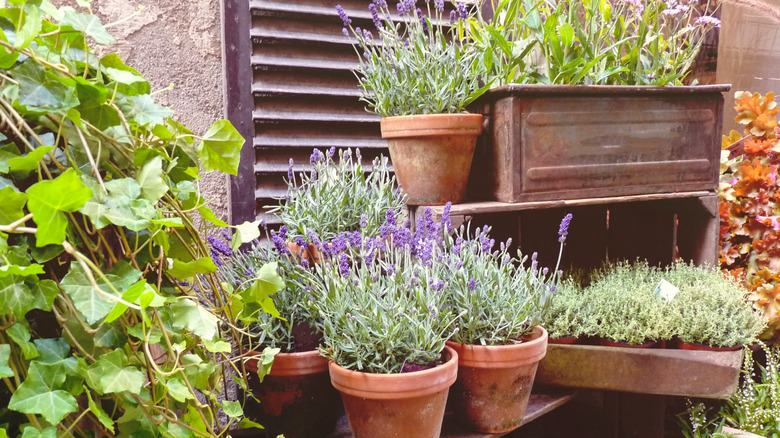The Best Spot In Your Garden To Plant Lavender
Lavender is an aromatic herb commonly grown in Mediterranean gardens. The naturally sandy soil, mild sunshine, and temperate climate provide a perfect environment for this fragrant herb. It is a great addition to an herb garden and grows well alongside basil, oregano, thyme, and rosemary. If you have a sunny spot with well-drained, slightly alkaline soil, this can be a suitable location for planting lavender.
There are a number of different types of lavender, and some are easier to cultivate than others because it can be quite particular about its growing zone. For example, English lavender (Lavandula angustifolia) is hardy in growing zones 5 to 9, while Portuguese lavender (Lavandula latifolia) is hardy in zones 6 to 8. Both French lavender (Lavandula dentata) and Spanish lavender (Lavandula stoechas) are hardy in zones 8 to 9. This means that in areas with cold winters, English lavender is the best option. Hidcote is a popular variety of English lavender often grown by home gardeners.
Before purchasing a lavender plant, check out the growing specifications to ensure it suits your growing zone, soil type, sunlight conditions, and other needs. Even if lavender isn't suitable to be planted as a perennial in your yard, you can always grow it as an annual in a container.
Growing needs of lavender
Lavender prefers well-drained, somewhat sandy, slightly alkaline, and "thin" soil (meaning soil that is not overly nutrient-rich.) Many gardeners assume they should automatically add compost and other amendments to enrich the soil, but some plants prefer less nutrient-rich soil, and lavender is one of them. If your soil is loose, well-drained, sandy, and naturally alkaline, then lavender may grow well in your garden. If your soil is loamy, that is a good start; adding a bit of sand will help increase the drainage. Clay soils are not a good growing environment for lavender, so you will probably want to try growing them in containers.
In addition to well-draining alkaline soil, lavender needs a good amount of sun to thrive and bloom. It is also relatively heat tolerant as long as the humidity is not too high. Plant your lavender where it will get at least five hours of direct sunlight per day.
Your lavender plants also require good air circulation, so give them plenty of room and make sure other plants do not crowd them. If you have a cottage-style garden, you can put them in front of the border to give them some space. Planting them along a walkway is also an excellent way to provide them with some air and space, and the scent of the flowers in bloom is delightful in summer.
Growing lavender in containers
If the soil conditions in your garden are not well-suited to lavender, you can try growing it in containers. This is also a good option if you want to cultivate the plant but your location isn't in the right growing zone (for example, USDA Zone 4, which is too cold for lavender). If you have a sunny spot in your garden that gets at least five hours of direct sun, you should be able to successfully grow the aromatic herb as an annual.
Terracotta clay pots are best for lavender, allowing for good drainage and moisture retention. If you use another kind of pot, be sure you have adequate drainage. A basic potting soil mix should be fine, but to give your lavender the best soil conditions, you can purchase potting soil made specifically for lavender. You can also mix your own lavender-friendly potting soil using three-part organic garden soil to one-part sand, and some added lime to make the soil more alkaline.
After planting your lavender in pots, water the plants daily to get them established, but be careful not to overwater. Lavender doesn't like too much humidity, and container plantings usually need extra watering in addition to rainfall. Let the soil surface of your lavender plantings dry out between waterings.


